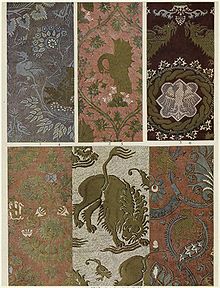
Back Damas AF بروكار دمشقي Arabic Дамаст BE Domàs Catalan Damašek (tkanina) Czech Дамаст CV Damask Danish Damast German Δαμάσκο Greek Damasko (ŝtofo) EO

Damask (/ˈdæməsk/; Arabic: دمشق) is a woven, reversible patterned fabric. Damasks are woven by periodically reversing the action of the warp and weft threads.[1] The pattern is most commonly created with a warp-faced satin weave and the ground with a weft-faced or sateen weave.[2] Yarns used to create damasks include silk, wool, linen, cotton, and synthetic fibers, but damask is best shown in cotton and linen.[1] Over time, damask has become a broader term for woven fabrics with a reversible pattern, not just silks.[3]
There are a few types of damask: true, single, compound, and twill. True damask is made entirely of silk.[3] Single damask has only one set of warps and wefts and thus is made of up to two colors. Compound damask has more than one set of warps and wefts and can include more than two colors.[3] Twill damasks include a twill-woven ground or pattern.[4]
- ^ a b Reath, N. A.; Jayne, Horace H. F. (1924). "A Classification of Hand-Loom Fabrics". Bulletin of the Pennsylvania Museum. 20 (89): 23–34. doi:10.2307/3794229. ISSN 0891-3609. JSTOR 3794229.
- ^ Kadolph, Sara J. (2007). Textiles (10th ed.). Upper Saddle River, N.J: Pearson Prentice Hall. ISBN 978-0-13-118769-6. OCLC 65197813.
- ^ a b c "Damask | Damask Weaving, Silk Fabric, Jacquard Loom | Britannica". www.britannica.com. Retrieved 2024-04-03.
- ^ Dimitrova, Kate (2009-10-22). "Kate Dimitrova. Review of "Merchants, Princes and Painters: Silk Fabrics in Italian and Northern Paintings, 1300–1550" by Lisa Monnas". Caa.reviews. doi:10.3202/caa.reviews.2009.107. ISSN 1543-950X.